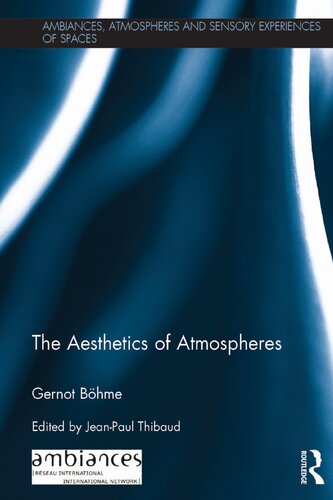

Most ebook files are in PDF format, so you can easily read them using various software such as Foxit Reader or directly on the Google Chrome browser.
Some ebook files are released by publishers in other formats such as .awz, .mobi, .epub, .fb2, etc. You may need to install specific software to read these formats on mobile/PC, such as Calibre.
Please read the tutorial at this link. https://ebooknice.com/page/post?id=faq
We offer FREE conversion to the popular formats you request; however, this may take some time. Therefore, right after payment, please email us, and we will try to provide the service as quickly as possible.
For some exceptional file formats or broken links (if any), please refrain from opening any disputes. Instead, email us first, and we will try to assist within a maximum of 6 hours.
EbookNice Team

Status:
Available4.4
29 reviews
ISBN 10: 1138688509
ISBN 13: 9781138688506
Author: Gernot Bohme, Jean Paul Thibaud
Interest in sensory atmospheres and architectural and urban ambiances has been growing for over 30 years. A key figure in this field is acclaimed German philosopher Gernot Böhme whose influential conception of what atmospheres are and how they function has been only partially available to the English-speaking public. This translation of key essays along with an original introduction charts the development of Gernot Böhme's philosophy of atmospheres and how it can be applied in various contexts such as scenography, commodity aesthetics, advertising, architecture, design, and art.
The phenomenological analysis of atmospheres has proved very fruitful and its most important, and successful, application has been within aesthetics. The material background of this success may be seen in the ubiquitous aestheticization of our lifeworld, or from another perspective, of the staging of everything, every event and performance. The theory of atmospheres becoming an aesthetic theory thus reveals the theatrical, not to say manipulative, character of politics, commerce, of the event-society. But, taken as a positive theory of certain phenomena, it offers new perspectives on architecture, design, and art. It made the spatial and the experience of space and places a central subject and hence rehabilitated the ephemeral in the arts. Taking its numerous impacts in many fields together, it initiated a new humanism: the individual as a living person and his or her perspective are taken seriously, and this fosters the ongoing democratization of culture, in particular the possibility for everybody to participate in art and its works.
Introduction
Part I. Theory: Aesthetics and aesthetical economy
1. Atmosphere as a fundamental concept of a new aesthetics
2. Atmosphere as an aesthetic concept
3. The art of the stage set as a paradigm for an aesthetics of atmospheres
4. Kant’s aesthetics: a new perspective
5. On beauty
6. On synaesthesiae
7. Contribution to the critique of the aesthetic economy
Part II. Aesthetics of nature and art
8. Aesthetic knowledge of nature
9. Nature in the age of its technical reproducibility
10. Body, nature and art
11. Nature as a subject
Part III. Architecture
12. The atmosphere of a CITY
13. Atmosphere as the subject matter of architecture
14. Staged materiality
15. Architecture: a visual art? On the relationship between modern architecture and photography
16. Metaphors in architecture–a metaphor?
Part IV. Light and sound
17. Acoustic atmospheres
18. Music and architecture
19. The great concert of the world
20. Seeing light
21. The phenomenology of light
Tags: Gernot Bohme, Jean Paul Thibaud, Aesthetics, Atmospheres